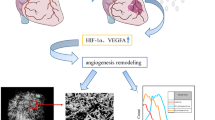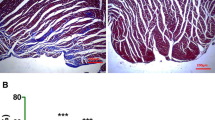Abstract
Long-term blockade of nitric oxide synthesis with Nω-nitro-L-arginine methyl ester (L-NAME) induces cardiac perivascular fibrosis in rats. Its relationship to expression of angiogenic growth factors and capillary network remodeling is not understood. This study was designed to determine whether capillary proliferation and angiogenic growth factor regulation occur in response to L-NAME. Three groups of rats were studied: C, control; L1, L-NAME 13 mg/kg/day; L2, 130 mg/kg/day. One and eight weeks later the hearts were removed and subjected to morphometric analysis and analysis of gene expressions of molecules related to angiogenesis. Arterial hypertension was observed within 8 weeks in the L1 and L2 groups compared with control. After 1 week immunohistochemical assays demonstrated basic fibroblast growth factor (bFGF) in the arteriolar media. Northern blot analysis revealed increase in bFGF and transforming growth factor-β (TGF-β) mRNA during this period. At 8 weeks arteriolar medial thickening and perivascular fibrosis were seen microscopically in the L1 and L2 groups, which were accompanied by only a modest remodeling of capillary network due to increase in venular or intermediate capillary portions. Concomitantly immunoreactivity for vascular endothelial growth factor (VEGF) and TGF-β were detected in perivascular area. These results suggest that (1) blockade of NO synthesis induces expression of angiogenic growth factors as well as vessel wall remodeling, and (2) TGF-β may counteract angiogenic growth factors and limit subsequent alterations in capillary network remodeling.
Similar content being viewed by others
References
Harrison DG. Cellular and molecular mechanisms of endothelial cell dysfunction. J Clin Invest 1997; 100: 2153–7.
Michel T, Feron O. Nitric oxide synthases: which, where, how, and why? J Clin Invest 1997; 100: 2146–52.
Moncada S, Higgs A. The L-arginine-nitric oxide pathway. N Engl J Med 1993; 329: 2002–12.
Cooke JP, Tsao P. Cellular mechanisms of atherogenesis and the effects of nitric oxide. Curr Opin Cardiol 1992; 7: 799–804.
Shears LL, Kawaharada N, Tzeng E TR et al. Inducible nitric oxide synthase suppresses the development of allograft arteriosclerosis. J Clin Invest 1997; 100: 2035–42.
Ito A, Egashira K, Kadokami T et al. Chronic inhibition of endothelium-derived nitric oxide synthesis causes coronary microvascular structural changes and hyperreactivity to serotonin in pigs. Circulation 1995; 92: 2636–44.
Kadokami T, Egashira K, Kuwata K et al. Altered serotonin receptor subtypes mediate coronary microvascular hyperreactivity in pigs with chronic inhibition of nitric oxide synthesis. Circulation 1996; 94: 182–9.
Numaguchi K, Egashira K, Takemoto M et al. Chronic inhibition of nitric oxide synthesis causes coronary microvascular remodeling in rats. Hypertension 1995; 26: 957–62.
Koyama T, Gao M, Batra S et al. Myocyte hypertrophy and capillarization in spontaneously hypertensive stroke-prone rats. In Nemoto and LaManna (ed): Oxygen Transport to Tissue XVIII. New York: Plenum Press 1997; 365–8.
Xie Z, Gao M, Batra S, Koyama T. Remodeling of capillary network in left ventricular subendocardial tissues induced by intravenous vasopressin administration. Microcirculation 1997; 4: 261–6.
Xie Z, Gao M, Batra S, Koyama T. The capillarity of left ventricular tissue of rats subjected to coronary artery occlusion. Cardiovasc Res 1997; 33: 671–6.
Koyama T, Xie Z, Gao M et al. Adaptive changes in the capillary network in the left ventricle of rat heart. Jpn J Physiol 1998; 48: 229–41.
Batra S, Rakusan K. Capillary length, tortuosity, and spacing in rat myocardium during cardiac cycle. Am J Physiol 1992; 263: H1369–76.
Gao M, Batra S, Koyama T et al. The capillarity of the subendocardium of left ventricle in rats reared at a low temperature for many generations. Acta Physiol Scand 1997; 160: 67–70.
Sawa H, Sobel BE, Fujii S. Inhibition of type-1 plasminogen activator inhibitor produced by antisense oligonucleotides in human vascular endothelial and smooth muscle cells. J Biol Chem 1994; 269: 14149–52.
Gilchrist M, MacDonald AJ, Neverova I et al. Optimization of the isolation and effective use of mRNA from rat mast cells. J Immunol Methods 1997; 201: 207–14.
Hashimoto E, Ogita T, Nakaoka T et al. Rapid induction of vascular endothelial growth factor expression by transient ischemia in rat heart. Am J Physiol 1994; 267: H1948–54.
Wu D, Kan M, Sato GH et al. Characterization and molecular cloning of a putative binding protein for heparin binding growth factors. J Biol Chem 1991; 266: 16778–85.
Schaper W, Ito W. Molecular mechanisms of coronary collateral growth. Circ Res 1996; 79: 911–9.
Unger EF, Banai S, Shou M et al. Basic fibroblast growth factor enhances myocardial collateral flow in a canine model. Am J Physiol 1994; 266: H1588–95.
Yanagisawa-Miwa A, Uchida Y, Nakamura F et al. Salvage of infarcted myocardium by angiogenication of basic fibroblast growth factor. Science 1992; 257: 1401–3.
Skalak TC, Price RJ. The role of mechanical stresses in microvascular remodeling. Microcircultation 1996; 3: 143–65.
Flamme I, Breier G, Risau W. Vascular endothelial growth factor (VEGF) and VEGF receptor 2 (flk-1) are expressed during vasculogenesis and vascular differentiation in the quail embryo. Developmental Biol 1995; 169: 699–712.
Border WA, Nobel NA. Transforming growth factor-β in tissue fibrosis. N Engl J Med 1994; 331: 1286–92.
Takemoto M, Egashira K, Usui M et al. Important role of tissue angiotensin-converting enzyme activity in the pathogenesis of coronary vascular and myocardial structural changes induced by long-term blockade of nitric oxide synthesis in rats. J Clin Invest 1997; 99: 278–87.
Tomita H, Egashira K, Ohara Y et al. Early induction of transforming growth factor-β via angiotensin II type 1 receptors contributes to cardiac fibrosis induced by long-term blockade of nitric oxide synthesis in rats. Hypertension 1998; 32: 273–9.
Hudetz AG. Percolation phenomenon: the effect of capillary network rarefaction. Microvasc Res 1993; 45: 1–10.
Biswal BB, Hudetz AG. Synchronous oscillations in cerebrocortical capillary red blood cell velocity after nitric oxide synthase inhibition. Microvasc Res 1996; 52: 1–12.
Hudetz AG, Shen H, Kampine JP. Nitric oxide from neuronal NOS plays critical role in cerebral capillary flow response to hypoxia. Am J Physiol 1998; 43: H982–9.
Mattfeldt T, Mall G. Growth of capillaries and myocardial cells in the normal rat heart. J Mol Cell Cardiol 1987; 19: 1237–46.
Warley A, Powell JM, Skepper JN. Capillary surface area is reduced and tissue thickness from capillaries to myocytes is increased in the left ventricle of streptozotocin-diabetic rats. Diabetologia 1995; 38: 413–21.
Thomas K. Vascular endothelial growth factor, a potent and selective angiogenic agent. J Biol Chem 1996; 271: 603–6.
Risau W. Mechanism of angiogenesis. Nature 1997; 386: 671–4.
Kourembanas S, Mcquillan LP, Leung GK, Faller DV. Nitric oxide regulates the expression of vasoconstrictors and growth factors by vascular endothelium under both normoxia and hypoxia. J Clin Invest 1993; 92: 99–104.
Tuder RM, Flook BE, Voelkel NF. Increased gene expression for VEGF and the VEGF receptors KDR/Flk and Flt in lungs exposed to acute or to chronic hypoxia: Modulation of gene expression by nitric oxide. J Clin Invest 1995; 95: 1798–807.
Stavri GT, Zachary IC, Baskerville PA, Martin JF. Basic fibroblast growth factor upregulates the expression of vascular endothelial growth factor in vascular smooth muscle cells. Circulation 1995; 92: 11–4.
Lazarous DF, Shou M, Scheinowitz M et al. Comparative effects of basic fibroblast growth factor and vascular endothelial growth factor on coronary collateral development and the arterial response to injury. Circulation 1996; 94: 1074–82.
Shou M, Thirumurti V, Rajanayagam MAS et al. Effect of basic fibroblast growth factor on myocardial angiogenesis in dogs with mature collateral vessels. J Am Coll Cardiol 1997; 29: 1102–6.
Xie Z, Gao M, Koyama T. Effects of transient coronary occlusion on the capillary network in the left ventricle of rat. Jpn J Physiol 1997; 47: 537–43.
Author information
Authors and Affiliations
Rights and permissions
About this article
Cite this article
Goto, D., Fujii, S., Zaman, A.T. et al. Long-term blockade of nitric oxide synthesis in rats modulates coronary capillary network remodeling. Angiogenesis 3, 137–146 (1999). https://doi.org/10.1023/A:1009050131966
Issue Date:
DOI: https://doi.org/10.1023/A:1009050131966




